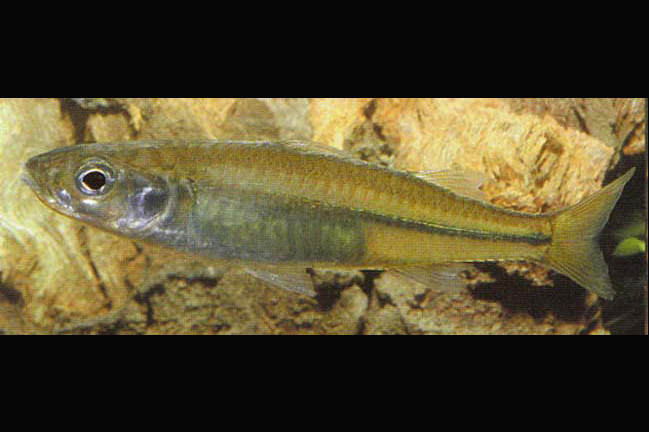Drysdale Hardyhead, Craterocephalus helenae Ivantsoff, Crowley & Allen 1987

Drysdale Hardyhead, Craterocephalus helenae. Source: Gerald R. Allen. License: All rights reserved
Drysdale Hardyhead, Craterocephalus helenae Ivantsoff, Crowley & Allen 1987
More Info
|
Distribution |
Known only from the Drysdale River, Kimberley region, north Western Australia. Inhabits rocky pools in clear still or flowing freshwater streams and channels. |
|
Features |
Dorsal fin V-VII + I, 6-7; Anal fin I, 7-8; Pectoral fin 12-13; Vertebrae 32-33; Gill rakers in 1st lower gill arch 8-10. Body laterally compressed, relatively elongate; greatest body depth 3.7-4.5 in SL; head relatively rounded and truncate; head length in SL 3.2-3.6; mouth small, protrusible with upper jaw extending slightly over lower when extended forward; gape restricted by fusion of lips; lips moderately thick; jaw teeth fine, pointing posteriorly; eye diameter in HL 3.2-3.8. Body scales large, almost rectangular and scalloped anteriorly; circuli on anterior half of scale; horizontal scale rows 6-8; vertical scale rows 30-32; preopercle with 4 scales and opercle with 4 large scale; first 4-5 scales on dorsum of head rectangular and large. Two separate dorsal fins; origin of first dorsal behind origin of ventral fin; origin of second dorsal fin above origin of anal fin; spines of first dorsal fin weak but not extended or filamentous; caudal fin forked. |
|
Size |
To 8 cm SL, commonly 5-6 cm. |
|
Colour |
Dusky dorsally with a silvery mid-lateral stripe and silver belly. |
|
Feeding |
Omnivorous feeding on aquatic insects, micro-crustaceans and some algae. |
|
Biology |
Little is known of the biology of this species but is likely to spawn in pairs depositing adhesive eggs amongst aquatic vegetation. |
|
Conservation |
Listed as Near Threatened on the IUCN Red List of Threatened Species. |
|
Remarks |
Craterocephalus helenae has been mis-identified as C. marjoriae in the past. |
|
Similar Species |
Craterocephalus helenae is most similar to C. marjoriae and C. marianae but differs in having a lower gill raker count, a higher midlateral scale count and on average a higher vertebrae count. |
|
Etymology |
Generic name Craterocephalus comes from the Greek meaning bowl or basin and head, possibly in reference to the strong head of species in this genus. Species is named helenae in honor of the senior author's wife Helena. |
|
Species Citation |
Craterocephalus helenae Ivantsoff, W., Crowley, L.E.L.M. & Allen, G.R. (1987). Descriptions of three new species and one subspecies of freshwater hardyhead (Pisces: Atherinidae: Craterocephalus) from Australia. Rec. West. Aust. Mus. 13(2): 171–188 [177, fig. 3 ]. Downstream from Gibb R. Road, Kimberley, WA [15°41'S, 126°32'E]. |
|
Author |
Vanessa J. Thompson |
Drysdale Hardyhead, Craterocephalus helenae Ivantsoff, Crowley & Allen 1987
References
Allen, G.R. (1989). Freshwater Fishes of Australia. Neptune, New Jersey : T.F.H. Publications pp. 1–240
Allen, G.R., Midgley, S.H. & Allen, M. (2002). Field guide to the freshwater fishes of Australia. Perth : Western Australian Museum 394 pp. [134].
Crowley, L.E.L.M. & Ivantsoff, W. (1992). Redefinition of the freshwater fish genus Craterocephalus (Teleostei: Atherinidae) of Australia and New Guinea with an analysis of three species. Ichthyol. Explor. Freshw. 3(3): 273–287
Merrick, J.R. & Schmida, G.E. (1984). Australian Freshwater Fishes Biology and Management. Sydney : J.R. Merrick 409 pp. (as C. sp. 1)
Wager, R. (1996). Craterocephalus helenae. In: IUCN 2010. IUCN Red List of Threatened Species. Version 2010.3. www.iucnredlist.org



